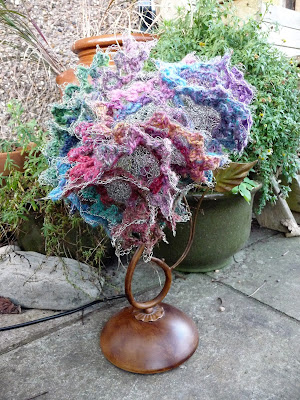My companion, Elinor Gotland, telephoned me to express her disgust at last week's blog, a review of Edie Eckman's new book 'Every Which Way Crochet Borders'.
'Well, Beaut, that poor woman designed and charted 139 customised edgings. And what did you do? Stick one frill on a lampshade. Creating a lamp no-one in their right mind would switch on, for fear of burning the house down."
'That lampshade is perfectly safe. Wool is naturally fire retardant.'
A small snort breezed through my mobile phone.
'So, you've put that death trap back on the bedside table have you? Best of luck, Beaut. I can see the headlines now. "Blogger electrocuted by crocheted wire."
Fair play, that would be a sensational marketing strategy.'
'Don't be daft, Elinor. The power supply to the bulb is totally separate to the wire in the lampshade.'
'Then you've no chance of generating any decent publicity. Mark my words, up your game, or Storey Publishing won't be sending you any more free books.'
Actually. those lovely edging patterns in the Crochet Borders book had already got my mind whirring. As well as crocheted and knitted items, Edie Eckman explains how to put a base round for any crochet border into woven fabric. One option is to use a fine crochet hook to poke through the weave near the edge, fetching up a loop of yarn, completing each crochet stitch with a larger hook. I tried it on a tubular section of brown onion dyed silk jersey, using a 0.5mm hook to pierce the hem, then a 2mm hook to crochet one of her borders in laceweight merino, which had also been dyed with brown onion skin. Bit of a nightmare, painfully slow process and I had to borrow himself's reading glasses to manage the fine yarn.
To go round the opposite edge of my cowl, I tried Edie's other method, sewing a mattress stitch hem, then crocheting the base round into the top line of that. Still time consuming with tiny stitches and it meant one side looked different, but no-one will notice and happily, the mattress stitch did also prove elastic enough to allow the silk jersey to stretch.
With two borders completed on the brown onion cowl, I moved on to hemming another, dyed with red onion skins. The book has a section showing the elements of crochet borders, encouraging the reader to try building up their own designs. I did have a few false starts and rather a disaster on the second edge. Bloody dog chewed up my last little ball of laceweight, intended for the final round of the second border.
Nonetheless, I consider both my silk cowls very much enhanced by their crochet borders. This is a really practical book in every respect - solidly constructed, well organised, straightforward to use and it teaches a jolly useful skill.
Thinking of these things, I had stopped paying attention to Elinor bleating on at me down the phone. Eventually I cut in.
'Actually, I have used some of Edie's other border designs and I am going to post another blog about her book.'
'Oh, bore me, why don't you? Two tedious blogs about stuff you made. People might be more interested in buying their own copy if they could try out a border themselves.'
'Well, Storey Publishing did say reviewers can post one of the patterns in full.'
Here is border number 32. Click on the photo and you can read it in full screen size.
'Why on earth didn't you do that last week? Of course, what you need to drum up trade for the book is a giveaway, a little competition, something fun. Since it's not safe to leave you to manage that by yourself, I shall have to come home on a rescue mission.'
'If you'd let me get a word in edgeways, I'd have told you. I'm not at home, I'm in America.' Silence followed. I enjoyed the moment, before continuing with my next revelation. 'I knew you'd be amazed. You'll never believe - I'm attending classes at the Madrona Fibre Retreat.'
'No .... what a nightmare!'
'How can you say that? It's my best Christmas present ever, from himself.'
'I'm thinking of my phone bill!'
The line went dead.
Anagram Competition
Rearrange these letters:
A STITCH IN EDGEWAYS
to make another sentence.
Doesn't matter if you have a few letters left over, the winner will be the sentence that makes me and Elinor laugh most.
To enter, email your sentence to me at tribulation2013@gmail.com before 31 March 2017
Storey Publishing will send a free copy of 'Every Which Way Crochet Borders' to the lucky winner, as long as they have an address in the UK, Europe, Canada or the USA.






























